
Neanderthal skullcap
In 1871, Darwin had
almost no fossil evidence to support his theory of the Descent
of Man from "simian" ancestors. He relied instead on
structural similarities with Primata, including information
supplied by Julian Huxley. The first human fossil had been
discovered in 1856 in the Neanderthal valley near Dusseldorf,
Germany. The
heavy brow ridges in this frontal view gave rise to the
popular picture of early humans as heavy-set, massively
built forms, with low foreheads (and by implication, low
intelligence). "Neanderthal Man" is now considered a subspecies of
Homo sapiens: H. s. neanderthalensis. Genetic evidence shows that though Neanderthals
were a separate evolutionary lineage from modern humans,
they coexisted in time and space, and could and did
interbreed. Many modern Homo sapiens have considerable
Neanderthal ancestry, as shown by DNA tests.
Text material ©2025 by Steven M. Carr